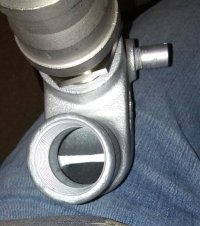SteveOO
Member I
I've been working on engine overheating issues due to low raw water flow in a 1980 38ft with the universal 5432. I've already cleaned the heat exchanger, replaced hoses and flushed the system with barnacle buster. Last piece in the system is the exhaust elbow.
Photos here:
Finally got that off, and it's definitely clogged, at least where the water enters the elbow. I'm going to clean up this existing elbow, but would like to get a backup to have onboard. There are no markings on this one, is it just a generic.. yanmar thing? It looks very similar to this one. Not sure how to find a replacement for the rectangular mounting bracket that goes to the exhaust manifold, or a gasket for that.
Is that lower 90 degree elbow that goes to the manfold another specialized part, or something more specialized? Would you even try cleaning my existing pieces up and reinstalling? I'm not sure if this is normal wear and tear but still functional, or on the brink of failure. Thanks for any input.
Photos here:
Finally got that off, and it's definitely clogged, at least where the water enters the elbow. I'm going to clean up this existing elbow, but would like to get a backup to have onboard. There are no markings on this one, is it just a generic.. yanmar thing? It looks very similar to this one. Not sure how to find a replacement for the rectangular mounting bracket that goes to the exhaust manifold, or a gasket for that.
Is that lower 90 degree elbow that goes to the manfold another specialized part, or something more specialized? Would you even try cleaning my existing pieces up and reinstalling? I'm not sure if this is normal wear and tear but still functional, or on the brink of failure. Thanks for any input.


